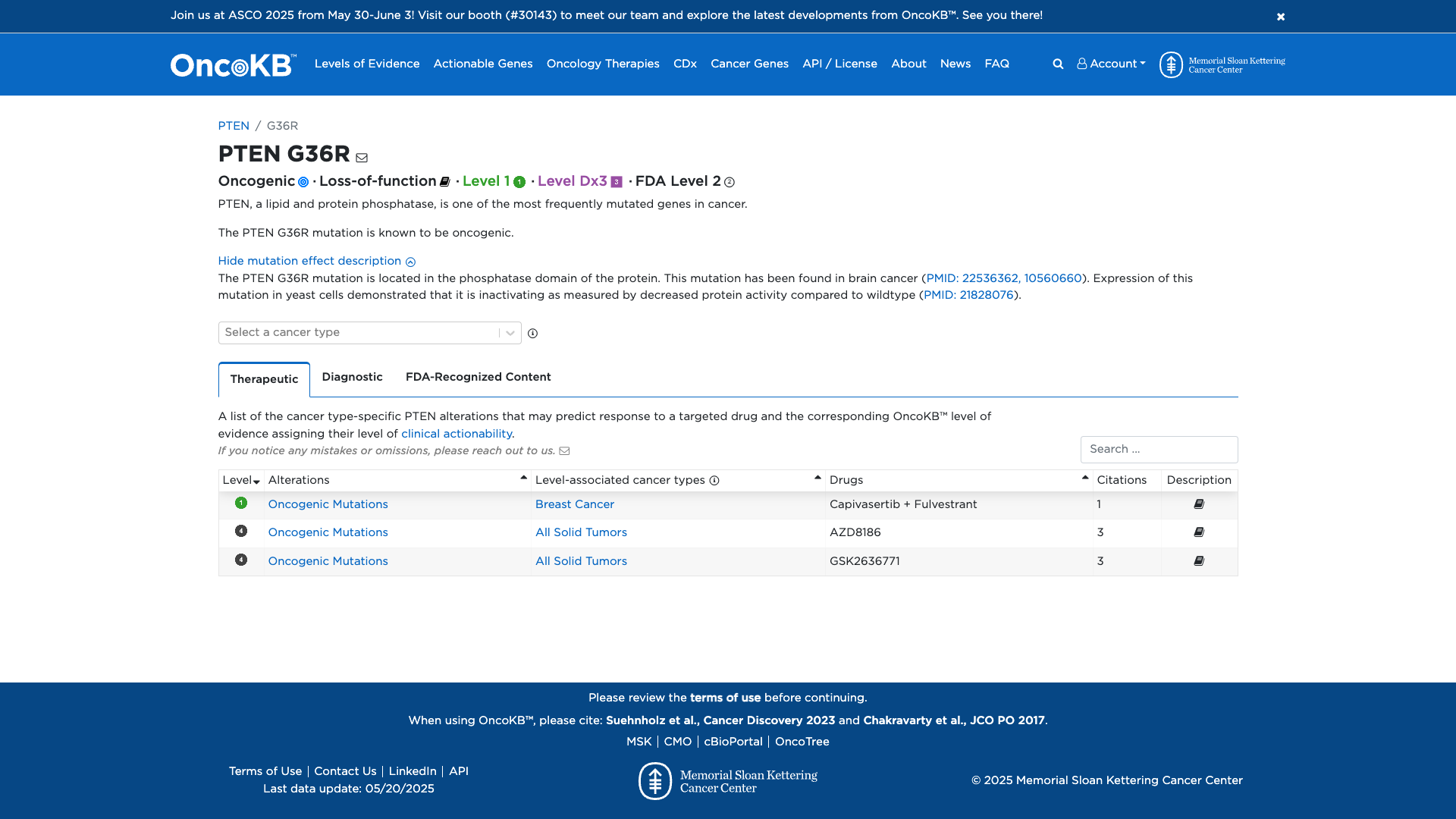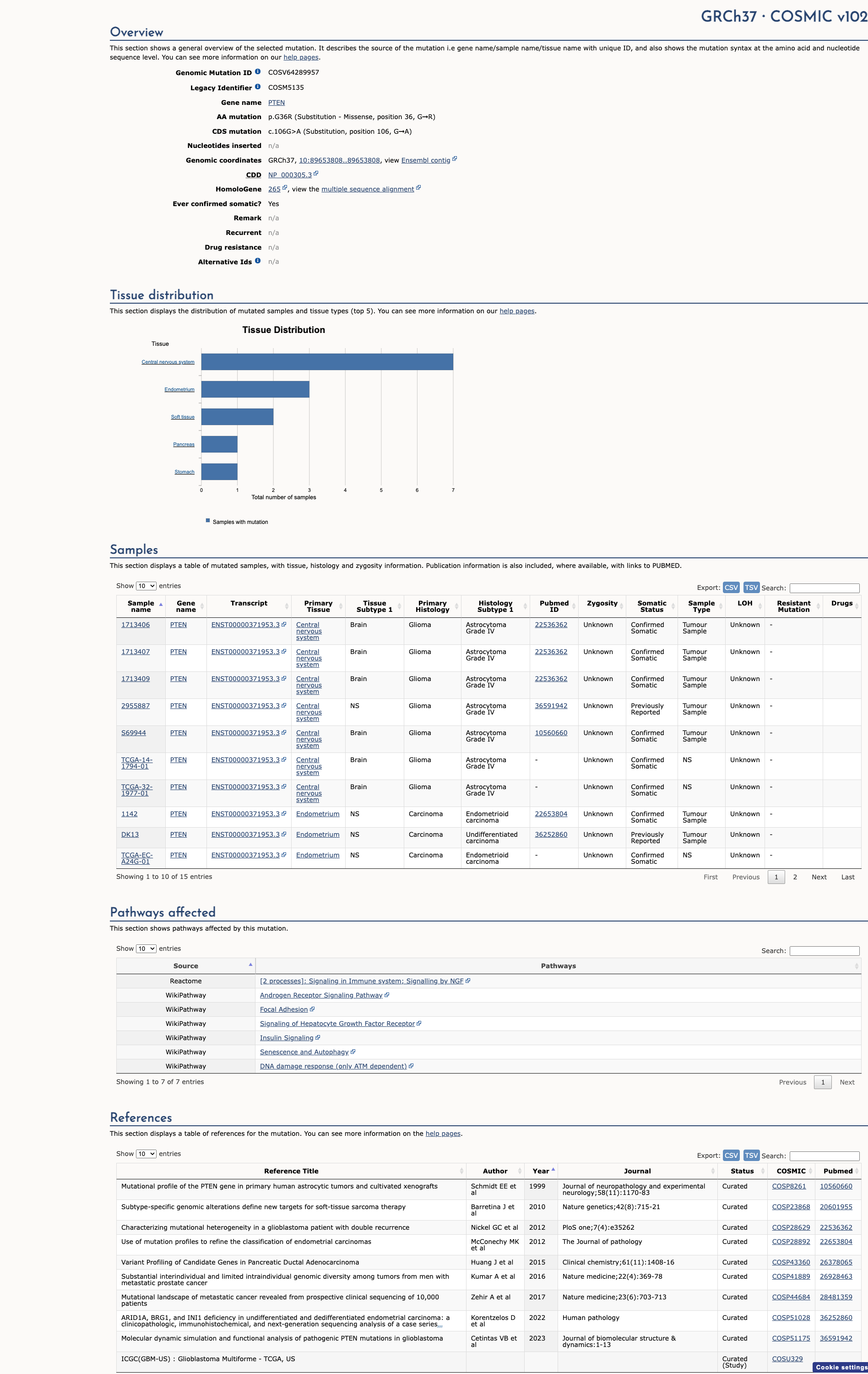PTEN c.106G>A, p.Gly36Arg
NM_000314.8:c.106G>A
COSMIC ID: COSM5135
Pathogenic
Based on a PTEN-specific moderate functional effect (PS3), absence from population (PM2), independent evidence of pathogenic residue change (PM5), computational/deposition support (PP2, PP3, PP5), the variant meets criteria for Likely Pathogenic under ACMG guidelines.
ACMG/AMP Criteria Applied
PS3
PM2
PM5
PP2
PP3
PP5
Genetic Information
Gene & Transcript Details
Gene
PTEN
Transcript
NM_000314.8
MANE Select
Total Exons
9
Strand
Forward (+)
Reference Sequence
NC_000010.10
Alternative Transcripts
| ID | Status | Details |
|---|---|---|
| NM_000314.7 | RefSeq Select | 9 exons | Forward |
| NM_000314.5 | Alternative | 9 exons | Forward |
| NM_000314.4 | Alternative | 9 exons | Forward |
| NM_000314.3 | Alternative | 9 exons | Forward |
| NM_000314.6 | Alternative | 9 exons | Forward |
Variant Details
HGVS Notation
NM_000314.8:c.106G>A
Protein Change
G36R
Location
Exon 2
(Exon 2 of 9)
5'Exon Structure (9 total)3'
Functional Consequence
Loss of Function
Related Variants
ClinVar reports other pathogenic variants at position 36: G36E
Alternate Identifiers
COSM5135
Variant interpretation based on transcript NM_000314.8
Genome Browser
Loading genome browser...
HGVS InputNM_000314:c.106G>A
Active Tracks
ConservationRefSeqClinVargnomAD
Navigation tips: Use mouse to drag and zoom. Click on features for details.
Clinical Data
Population Frequency
Global Frequency
0.0 in 100,000
Extremely Rare
Global: 0.0%
0%
0.05%
0.1%
1%
5%
10%+
ACMG Criteria Applied
PM2
This variant is not present in gnomAD (PM2 criteria applies).
Classification
3 publications
Likely Pathogenic
Based on 4 submitter reviews in ClinVar
Submitter Breakdown
1 Path
3 LP
Pathogenic
Likely Path.
VUS
Likely Benign
Benign
Publications (3)
This variant is considered likely pathogenic. This variant has been reported in multiple individuals with clinical features of gene-specific disease [PMID: 10772390, 32442409, 17942903]. This variant is expected to disrupt protein structure [Myriad internal data]. Functional studies indicate this variant impacts protein function [PMID: 32350270].
The p.G36R variant (also known as c.106G>A), located in coding exon 2 of the PTEN gene, results from a G to A substitution at nucleotide position 106. The glycine at codon 36 is replaced by arginine, an amino acid with dissimilar properties. This alteration was detected in one individual with clinical features of Cowden syndrome, including: trichilemmomas, oral papillomatosis, acral keratosis, breast cancer, hypothyroidism, gastrointestinal polyps, macrocephaly, and uterine fibroids (Celebi JT et al. Exp. Dermatol., 2000 Apr;9:152-6). In addition, this alteration was detected in 1 of 802 subjects undergoing PTEN genetic testing; however, individual phenotype information was not provided (Pilarski R et al. J. Med. Genet., 2011 Aug;48:505-12). In a massively parallel functional assay using a humanized yeast model, lipid phosphatase activity for this variant was functionally deficient (Mighell TL et al. Am J Hum Genet, 2018 May;102:943-955). In a functional study using a yeast-based assay, this variant demonstrated severely reduced phosphatase activity when compared to wild type PTEN and was similar to the catalytic dead control (Rodríguez-Escudero I et al. Hum. Mol. Genet. 2011 Nov;20:4132-42). This amino acid position is highly conserved in available vertebrate species. This missense alteration is located in a region that has a low rate of benign missense variation (Lek M et al. Nature. 2016 Aug 18;536(7616):285-91; DECIPHER: Database of Chromosomal Imbalance and Phenotype in Humans using Ensembl Resources. Firth H.V. et al. 2009. Am.J.Hum.Genet. 84, 524-533 (DOI: dx.doi.org/10/1016/j.ajhg.2009.03.010)). This variant is considered to be rare based on population cohorts in the Genome Aggregation Database (gnomAD). In addition, this alteration is predicted to be deleterious by in silico analysis. Based on the majority of available evidence to date, this variant is likely to be pathogenic.
This sequence change replaces glycine, which is neutral and non-polar, with arginine, which is basic and polar, at codon 36 of the PTEN protein (p.Gly36Arg). This variant is not present in population databases (gnomAD no frequency). This missense change has been observed in individuals with clinical features of Cowden syndrome (PMID: 10772390, 32442409; Invitae). ClinVar contains an entry for this variant (Variation ID: 1334551). Advanced modeling of protein sequence and biophysical properties (such as structural, functional, and spatial information, amino acid conservation, physicochemical variation, residue mobility, and thermodynamic stability) performed at Invitae indicates that this missense variant is expected to disrupt PTEN protein function with a positive predictive value of 80%. Experimental studies have shown that this missense change affects PTEN function (PMID: 17942903, 21828076, 25875300). In summary, the currently available evidence indicates that the variant is pathogenic, but additional data are needed to prove that conclusively. Therefore, this variant has been classified as Likely Pathogenic.
Clinical Statement
This variant has been reported in ClinVar as Pathogenic (1 clinical laboratories) and as Likely pathogenic (3 clinical laboratories) and as Likely pathogenic by Clingen PTEN Variant Curation Expert Panel, Clingen expert panel.
Expert Panel Reviews
Likely pathogenic
Clingen PTEN Variant Curation Expert Panel, Clingen
Functional Impact
Functional Domain
Hotspot Status
Not a hotspot
Domain Summary
This variant is not located in a mutational hotspot or critical domain (0 mutations).
Related Variants in This Domain
ClinVar reports other pathogenic variants at position 36: G36E
PM5 criterion applied.
Functional Summary
The PTEN G36R variant has been functionally characterized and is known to be damaging. It results in impaired nuclear localization and loss of phosphatase activity, as demonstrated in yeast models. This mutation is located in the phosphatase domain of PTEN and is associated with oncogenic activity.
Database Previews
OncoKB

JAX-CKB

Click on previews to view full database entries. External databases may require institutional access.
Computational Analysis
Pathogenicity Predictions
REVEL Score
0.995
0.995
Likely Benign0.0
Uncertain (Low)0.2
Uncertain (Med)0.5
Likely Pathogenic0.75
REVEL scores ≥ 0.75 are strong evidence (PP3)
Predictor Consensus
Pathogenic
PP3 Applied
Yes
Additional Predictors
Pathogenic:
sift: Dpolyphen_prediction: probably_damagingmutationtaster: Dmutationassessor: Hfathmm: Dprovean: Dmetasvm: Dmetalr: Dprimateai: Ddeogen2: D
Benign:
CADD: 5.86
VCEP Guidelines
Applied ACMG/AMP Criteria (VCEP Specific) VCEP Guidelines
PVS1
PVS1 (Not Applied) Strength Modified
According to VCEP guidelines, PVS1 applies only to null variants (loss-of-function); the variant is a missense change (G36R) and does not produce a null allele. Therefore, this criterion is not applied.
PS1
PS1 (Not Applied) Strength Modified
According to VCEP guidelines, PS1 applies when the variant results in the same amino acid change as an established pathogenic variant. The G36R change is unique and no identical amino acid change has been previously reported as pathogenic. Therefore, this criterion is not applied.
PS2
PS2 (Not Applied) Strength Modified
According to standard ACMG guidelines, PS2 (Strong) requires confirmed de novo occurrence. No parental or de novo data are available. Therefore, this criterion is not applied.
PS3
PS3 (Moderate) Strength Modified
According to PTEN Pre-processing, the rule for PS3 (Moderate) is: "Phosphatase activity ≤ -1.11 per Mighell et al. 2018, PMID: 29706350." The variant’s phosphatase activity score is -2.6930 (< -1.11). Therefore, this criterion is applied at Moderate strength.
PS4
PS4 (Not Applied) Strength Modified
According to standard ACMG guidelines, PS4 requires increased prevalence in affected individuals versus controls. No case-control or proband specificity data are available. Therefore, this criterion is not applied.
PM1
PM1 (Not Applied) Strength Modified
According to VCEP guidelines, PM1 (Moderate) applies to residues in defined catalytic motifs (90-94, 123-130, 166-168). Residue 36 is outside these hotspots. Therefore, this criterion is not applied.
PM2
PM2 (Supporting) Strength Modified
According to VCEP guidelines, PM2 (Supporting) is: "Absent in population databases at <0.00001 allele frequency." The variant is absent from gnomAD. Therefore, this criterion is applied at Supporting strength.
PM3
PM3 (Not Applied) Strength Modified
According to standard ACMG guidelines, PM3 applies to recessive disorders with trans observations. PTEN-associated disease is autosomal dominant and no trans data exist. Therefore, this criterion is not applied.
PM4
PM4 (Not Applied) Strength Modified
According to VCEP guidelines, PM4 applies to in-frame indels affecting protein length. The variant is a missense substitution. Therefore, this criterion is not applied.
PM5
PM5 (Moderate)
According to VCEP guidelines, PM5 (Moderate) is: "Missense change at an amino acid residue where a different missense change determined to be pathogenic or likely pathogenic has been seen before, with BLOSUM62 score equal or less than known variant." A different pathogenic missense at residue 36 has been reported and the Gly→Arg BLOSUM62 score (-2) meets the requirement. Therefore, this criterion is applied at Moderate strength.
PM6
PM6 (Not Applied) Strength Modified
According to standard ACMG guidelines, PM6 (Moderate) requires assumed de novo occurrence without confirmation. No de novo data are available. Therefore, this criterion is not applied.
PP1
PP1 (Not Applied) Strength Modified
According to VCEP guidelines, PP1 requires co-segregation in multiple affected family members. No segregation data are available. Therefore, this criterion is not applied.
PP2
PP2 (Supporting)
According to standard ACMG guidelines, PP2 (Supporting) is: "Missense variant in a gene with low rate of benign missense variation where missense is a common mechanism of disease." PTEN is highly constrained and missense variants are established disease mechanisms. Therefore, this criterion is applied at Supporting strength.
PP3
PP3 (Supporting)
According to VCEP guidelines, PP3 (Supporting) for missense requires REVEL score >0.7. The variant’s REVEL score is 0.99. Therefore, this criterion is applied at Supporting strength.
PP4
PP4 (Not Applied) Strength Modified
According to standard ACMG guidelines, PP4 requires a highly specific phenotype. No patient phenotype data are provided. Therefore, this criterion is not applied.
PP5
PP5 (Supporting)
According to standard ACMG guidelines, PP5 (Supporting) is: "Reputable source recently reports variant as pathogenic without available evidence." The variant is reported as Pathogenic or Likely Pathogenic by multiple ClinVar submitters and the ClinGen PTEN Expert Panel. Therefore, this criterion is applied at Supporting strength.
BA1
BA1 (Not Applied) Strength Modified
According to VCEP guidelines, BA1 (Stand Alone) applies if allele frequency >0.00056. The variant is absent from controls. Therefore, this criterion is not applied.
BS1
BS1 (Not Applied) Strength Modified
According to VCEP guidelines, BS1 (Strong) applies for allele frequency from 0.000043 to 0.00056. The variant is absent. Therefore, this criterion is not applied.
BS2
BS2 (Not Applied) Strength Modified
According to VCEP guidelines, BS2 requires homozygous observations in healthy individuals. No such data are available. Therefore, this criterion is not applied.
BS3
BS3 (Not Applied) Strength Modified
According to VCEP guidelines, BS3 applies when functional studies show no damaging effect. The variant’s functional studies demonstrate damaging impact. Therefore, this criterion is not applied.
BS4
BS4 (Not Applied) Strength Modified
According to VCEP guidelines, BS4 requires lack of segregation in affected family members. No segregation data are available. Therefore, this criterion is not applied.
BP1
BP1 (Not Applied) Strength Modified
According to standard ACMG guidelines, BP1 applies to genes where only truncating variants cause disease. PTEN disease is caused by both truncating and missense variants. Therefore, this criterion is not applied.
BP2
BP2 (Not Applied) Strength Modified
According to VCEP guidelines, BP2 requires observation in trans with a pathogenic PTEN variant. No such data are available. Therefore, this criterion is not applied.
BP3
BP3 (Not Applied) Strength Modified
According to VCEP guidelines, BP3 applies to in-frame indels in repeat regions. The variant is missense. Therefore, this criterion is not applied.
BP4
BP4 (Not Applied) Strength Modified
According to VCEP guidelines, BP4 requires benign computational evidence (REVEL <0.5). The variant’s REVEL score is 0.99. Therefore, this criterion is not applied.
BP5
BP5 (Not Applied) Strength Modified
According to VCEP guidelines, BP5 applies when an alternate molecular basis exists. No alternate diagnosis data are provided. Therefore, this criterion is not applied.
BP6
BP6 (Not Applied) Strength Modified
According to VCEP guidelines, BP6 applies when a reputable source reports a variant as benign. No such reports exist. Therefore, this criterion is not applied.
BP7
BP7 (Not Applied) Strength Modified
According to VCEP guidelines, BP7 applies to synonymous or intronic variants with no splice impact. This variant is missense. Therefore, this criterion is not applied.

